Test geek and founder of Aptitude-Test-Prep.com
What Is the Saville Assessment?
The Saville Assessment is not a single assessment, but rather one of 6 different assessments, developed and administered by Saville Consulting. The 2 most popular Saville assessments are Saville Swift Analysis Aptitude and Saville Swift Executive Aptitude, for which we dedicate separate sections.
Every Saville Assessment includes 3-6 “testlets” (test topics), taken from a pool of 7 testlets.
The Complete Saville Assessments Table
N – Numerical, V – Verbal, D – Diagrammatic, A – Abstract, C – Checking, S – Spatial, M – Mechanical
| Assessment |
Testlets |
Questions |
Minutes |
| Analysis Aptitude |
N, V, D |
24 |
18 |
| Executive Aptitude |
N, V, A |
24 |
18 |
| Comprehension Aptitude |
N, V, C |
48 |
18 |
| Apprentice Aptitude |
N, V, D, C, S, M |
No Info |
19 |
| Technical Aptitude |
S, M, D |
No Info |
10 |
| Analysis Verbal & Numerical |
V, N |
No Info |
24 |
In the Testlets section you can find sample questions and answers of the 4 main Saville test sections, which are probably most relevant to you – numerical, verbal, abstract, and diagrammatic.
Saville’s tests are timed at 18 minutes. However, the faster you work, the higher your score will be (as long as your answers are correct).
Here’s an excerpt from a Saville Swift Analysis score report that shows the way the test assesses both your speed and accuracy.
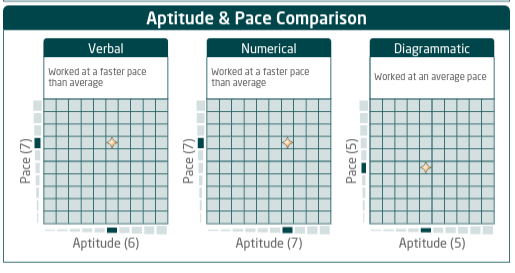
Saville Swift Analysis
The Saville Swift Analysis Aptitude Test is Saville’s most popular assessment. It is used to screen graduates, middle and top managers, professionals, and directors.
The assessment contains 3 testlets:
- Numerical Analysis
- Verbal Analysis
- Diagrammatic Analysis
The dedicated Saville Swift Analysis section includes more details on the assessment and a free practice test.
Saville Swift Analysis Aptitude Test Preparation
JobTestPrep’s Saville Swift Analysis Aptitude Test Preparation is the best prep course available today.
What Do You Get?
Mock Tests
- 3 Swift Analysis Aptitude Practice Tests
Additional Practice Tests
- 23 Verbal Analysis Practice Tests
- 20 Numerical Analysis Practice Tests
- 3 Diagrammatic Analysis Practice Tests
Smart Score Reports, Full Answers & Tips

Full Disclosure: We are affiliated with JobTestPrep. Clicking the links helps us provide you with high-quality, ad-free content.
Saville Swift Executive
The Saville Swift Executive Aptitude Test is Saville’s most challenging assessment. It is used to screen candidates for “high-complexity jobs” such as senior leaders and executives. However, it may also be used for lucrative graduate jobs as well.
The assessment contains 3 testlets:
- Numerical Analysis
- Verbal Analysis
- Abstract Analysis
The dedicated Saville Swift Executive section includes more details on the assessment and a free practice test.
Saville Swift Executive Aptitude Test Preparation
JobTestPrep’s Saville Swift Executive Aptitude Test Preparation is the best prep course available today.
What Do You Get?
Mock Tests
- 3 Swift Executive Aptitude Practice Tests
Additional Practice Tests
- 23 Verbal Reasoning Practice Tests
- 28 Numerical Reasoning Practice Tests
- 12 Abstract Reasoning Practice Tests
Smart Score Reports, Full Answers & Tips

Full Disclosure: We are affiliated with JobTestPrep. Clicking the links helps us provide you with high-quality, ad-free content.
Saville Swift Analysis Aptitude
The Saville Swift Analysis test contains 24 questions in three sections (testlets):
- Numerical Analysis (8 questions)
- Verbal Analysis (8 questions)
- Abstract Analysis (8 questions)
Each section is solved as a separate test and takes 6 minutes to complete, so overall, 18 minutes.
Free Saville Analysis Aptitude Sample Test
This practice test contains 18 questions and is an authentic representation of the actual Saville Analysis assessment in terms of question difficulty, type, and structure.
To maintain a realistic experience, allow yourself 6 minutes for each section.
Good luck!
For a more in-depth overview of the test sections and types of questions, check out the Testlets section of this page.
Diagrammatic Reasoning
Question #1

Answer and Explanation
The correct answer is 3.
Operator X changes the middle shape and maintains its color. Therefore, the original middle shape should be a white circle, and both shapes on the sides remain unchanged.
○○●→○□●
Question #2
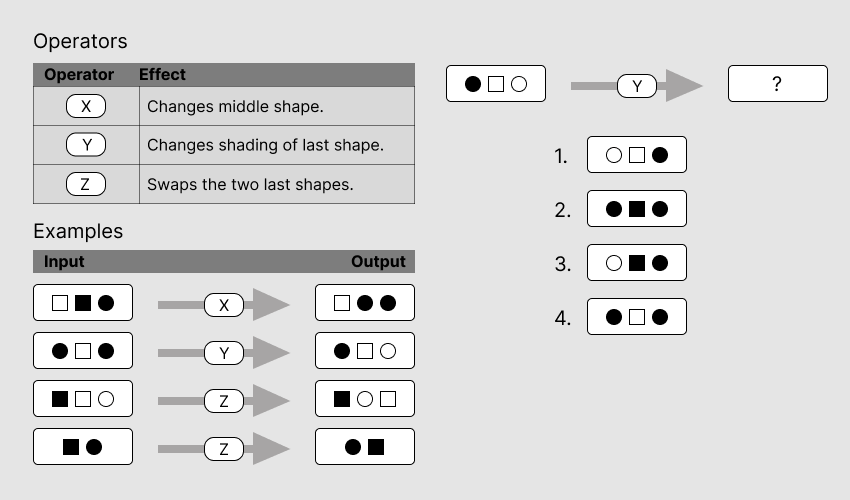
Answer and Explanation
The correct answer is 4.
Operator Y changes the shading of the last shape from a white circle to a black circle.
●□○→●□●
Question #3
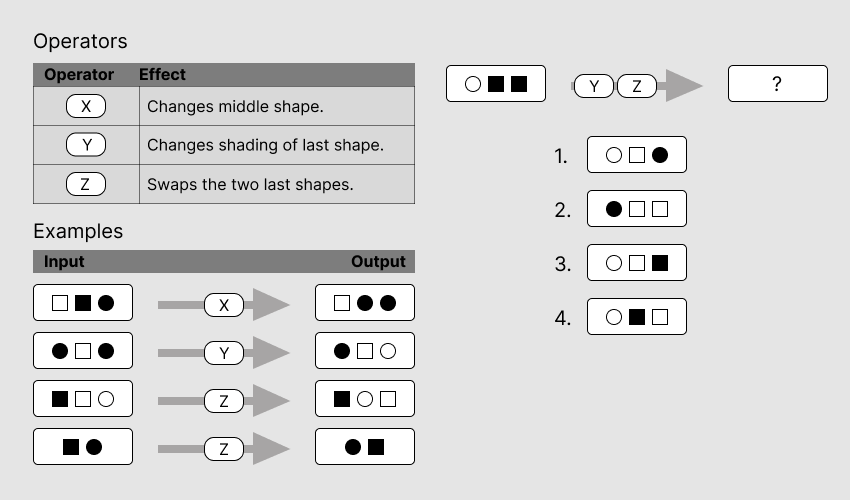
Answer and Explanation
The correct answer is 3.
Going from left to right:
Step 1 – Operator Y changes the shading of the last shape from a black square to a white square.
○■■→○■□
Step 2 – Operator Z swaps the two last shapes.
○■□→○□■
Question #4

Answer and Explanation
The correct answer is 4.
Going from left to right:
Step 1 – Operator Z swaps the two last shapes (black and white squares).
■■□→■□■
Step 2 – Operator X changes the middle shape (white square) to circle.
■□■→■○■
Question #5

Answer and Explanation
The correct answer is 1.
Operator Y changes the coloring of the last shape (circle) from black to white.
□●→□○
Question #6
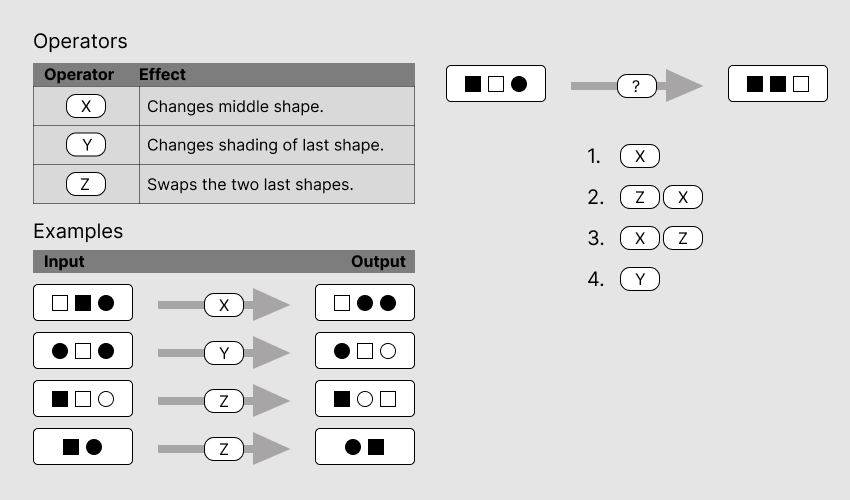
Answer and Explanation
The correct answer is 2.
Going from left to right:
Step 1 – Operator Z swaps the last two shapes (white square and black circle).
■□●→■●□
Step 2 – Operator X changes the middle shape from a black circle to a black square.
■●□→■■□
Question #7
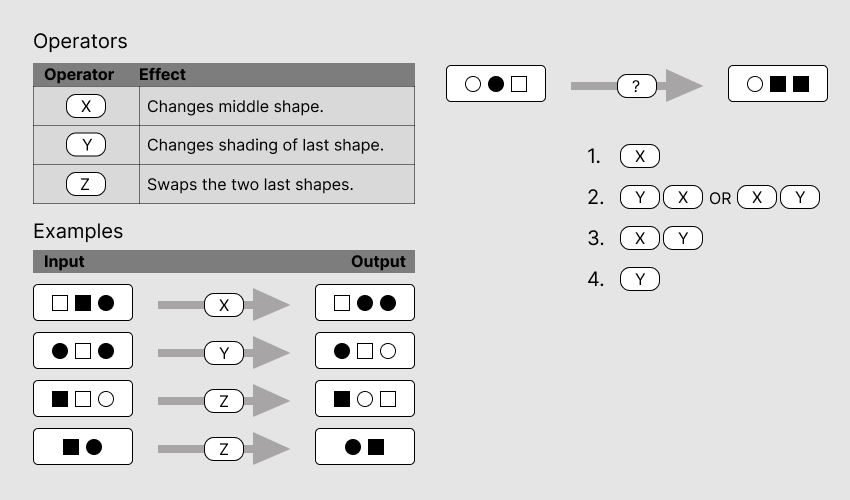
Answer and Explanation
The correct answer is 3.
Going from left to right:
Step 1 – Operator X changes the middle shape (black circle) to a black square.
○●□→○■□
Step 2 – Operator Y changes the coloring of the last shape from a white square to a black square.
○●□→○■■
Question #8

Answer and Explanation
The correct answer is 1.
Going from left to right:
Step 1 – Operator Z swaps the black and white squares.
○□■→○■□
Step 2 – Operator X changes the middle shape from a black square to a black circle.
○■□→○●□
Step 3 – Operator Z swaps the black circle and white square.
○●□→○□●
Numerical Analysis
Question #1
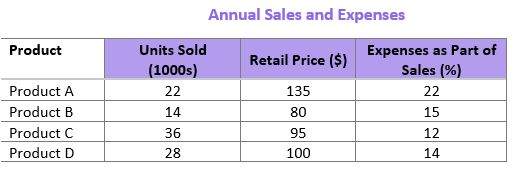
What was the average price for which a product was sold this year?
- $102.5
- $110
- $103.1
- $100.5
Answer and Explanation
The correct answer is C.
To find the average selling price, we should divide the total sales revenue made by the total number of products sold, so:
[22 x 135 + 14 x 80 + 36 x 95 + 28 x 100] / [22 + 14 + 36 + 28] = 10,310 / 100 = 103.1.
Since the number of units sold is given in 1000s for all products, we can disregard the 1000s and calculate with the original numbers given in the table.
Note that simply finding the average of all 4 product prices, i.e., (135 + 80 + 95 + 100) / 4 = $102.5 is WRONG. That is because not all products have the same “weight” in the total revenue.
Question #2

Product A was more profitable than Product D.
- True
- False
- Cannot Say
Answer and Explanation
The correct answer is False.
The following table shows the total revenue and profit for all 4 products:
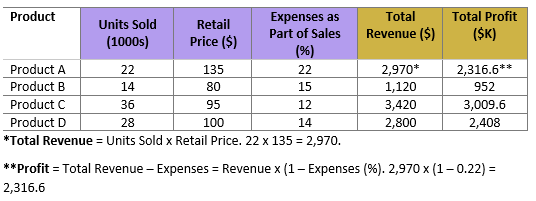
So, while Product A has generated more revenue than Product D, it is less profitable, due to its greater expenses.
Question #3

What was the total number of products sold in Y1?
- 1,357
- 1,125
- 1,241
- 2,482
Answer and Explanation
The correct answer is B.
158 + 622 + 235 + 110 = 1,125
Question #4

Which product has shown the greatest increase in revenue between Y1 and Y2?
- Product A
- Product B
- Product C
- Product D
Answer and Explanation
The correct answer is B.
You may want to solve it differently, but for convenience we’ll show the solution in a table.
|
Product A |
Product B |
Product C |
Product D |
| Y2 |
166 |
755 |
224 |
212 |
| Y1 |
158 |
622 |
235 |
110 |
| Y2-Y1 |
8 |
133 |
-11 |
102 |
| Price |
$15 |
$7 |
$20 |
$8 |
| Revenue |
$120 |
$931 |
-$220 |
$816 |
For example, the increase in revenue for Product A between Y1 and Y2 was:
(166 – 158) x $15 = 8 x $15 = $120.
The total increase in revenue is the sum of all revenue increase (all 4 products):
120 + 931 – 220 + 816 = 1,647.
Question #5

The company’s analysts predict high demand for Product D in Y3, while all other products are expected to yield the same revenue as in Y2. They suggest a price increase on Product D in Y3.
Assuming that the number of Product D units sold remains constant, what is the lowest price required for Product D to become the company’s most revenue-generating product in Y3?
- $17
- $27
- $32.5
- $25
Answer and Explanation
The correct answer is D.
The following table presents the expected revenue for all products in Y2:
|
A |
B |
C |
D |
| Units Sold |
166 |
755 |
224 |
212 |
| Avg. Price |
$15 |
$7 |
$20 |
$8 |
| Revenue |
$2,490 |
$5,285 |
$4,480 |
$1,696 |
Product B is the company’s most revenue-generating product in Y2, with a $5,285 revenue. Therefore, for product D to become the most revenue-generating product in Y3, it should yield at least that amount.
Assuming that Product D sells the same number of units in Y3 as in Y2, the new price for it to be the company’s most revenue is:
212 x New Price = $5,285
New Price = $24.92
Therefore, of the given options, $25 is the lowest price that will put product D as the most revenue-generating product in Y3.
Question #6
Refer to the graph below for questions 6-8.
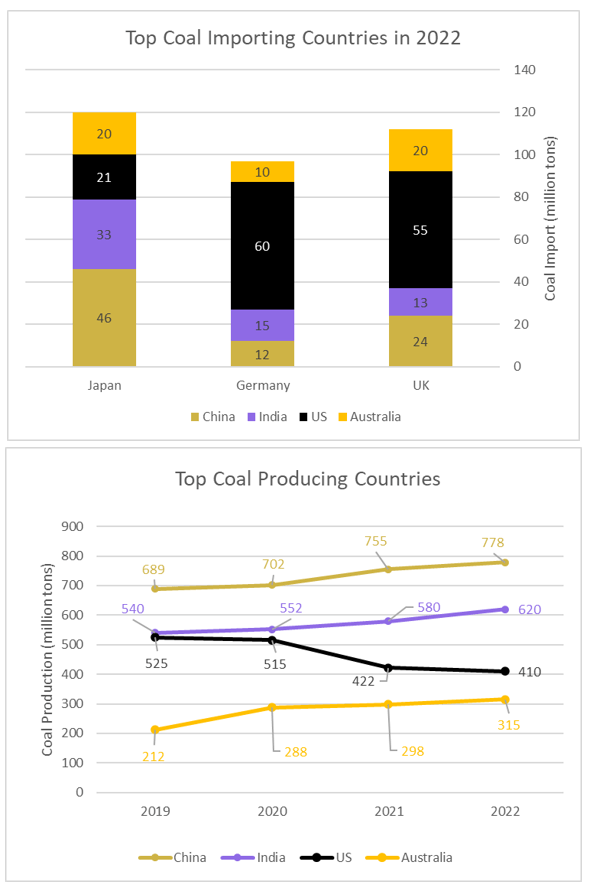
What percentage of Japan’s coal is imported from Australia?
- 7%
- 20%
- 12%
- 3%
Answer and Explanation
The correct answer is A.
The total coal imported by Japan is (20 + 21 + 33 + 46) = 120 million tons.
The percentage of coal imported from Australia is, therefore, (20/120) = 16.7%
Question #7
Which of the following countries exports the lowest percentage of its coal to the three top importing countries in 2022?
- China
- India
- US
- Australia
Answer and Explanation
The correct answer is B.
The following table shows the total coal production of the 4 top coal producing countries and the total coal imports by the top 3 coal importing countries.
| Country |
Total Production |
Total Exports to UK, Germany, and Japan |
Exports (% of Production) |
| China |
778 |
24 + 12 + 46 = 82 |
82 / 778 = 10.5% |
| India |
620 |
61 |
9.8% |
| US |
410 |
136 |
33.1% |
| Australia |
315 |
50 |
15.9% |
Therefore, India exports the lowest percentage of its coal to UK, Germany, and Japan.
Question #8
By 2023, the following trends are expected to occur in the top coal producing countries, with comparison to 2022:
- China – 5% decrease.
- India – 3% increase.
- US – 8% decrease.
- Australia – No change.
Approximately, what will be the total coal production of the 4 top coal producing countries in 2023 (in million tons)?
- 2,155
- 2,123
- 2,066
- 1,998
Answer and Explanation
The correct answer is C.
Again, let’s summarize the data in a table:
|
2022 |
Change |
2023 |
| China |
778 |
-0.05 |
739.1 |
| India |
620 |
0.03 |
638.6 |
| US |
410 |
-0.09 |
373.1 |
| Australia |
315 |
0 |
315 |
| Total |
2,123 |
|
2,065.8 |
Therefore, the total production of all 4 top coal producing countries in 2023 will be approximately 2,066 million tons.
Verbal Analysis
Text for questions 1-5
Limnic eruption is a very rare type of natural disaster. A very unique combination of circumstances is required to produce such an event, which occurs only in deep volcanic crater lakes near the equator. Therefore, only two cases are documented – the first in Lake Monoun, and the second in Lake Nyos. Both lakes are located in Cameroon, Africa. Nearly 1,800 people have lost their lives in these two events.
While technological solutions have been implemented to prevent further eruptions in these relatively small lakes, local authorities have thus far failed in providing a solution for the enormous Lake Kivu on the Rwanda-DRC border. Experts predict that if a limnic eruption ever takes place in Lake Kivu, it may be the worst natural disaster in modern history.
Question #1
Which word could replace “circumstances” and maintain the original meaning of the sentence?
- resources
- conditions
- eruptions
- failures
Answer and Explanation
The correct answer is B.
The text details a specific combination of conditions/circumstances that need to apply simultaneously for a lake to go through limnic eruption.
Question #2
According to the text, what is the most probable reason that no technology to prevent limnic eruptions was installed in Lake Kivu?
- Its surroundings are too densely populated.
- Authorities in the area are corrupt.
- It lies on a border.
- It is too big.
Answer and Explanation
The correct answer is D.
The text states that “While technological solutions have been implemented…in these relatively small lakes local authorities have thus far failed in providing a solution for the enormous Lake Kivu on the Rwanda-DRC border.”
Therefore, since the text compares the enormous Lake Kivu to the relatively small Lake Nyos and Lake Monoun, it is most probable that this is the reason that no technology was implemented in that lake. While options B (corrupt authorities) and C (lies on a border) are factually true, the text does not suggest them as a reason for the failure in providing a solution for Lake Kivu.
Question #3
Lake Kivu is a deep volcanic crater lake.
- True
- False
- Cannot Say
Answer and Explanation
The correct answer is True.
According to the text, limnic eruptions occur only in deep volcanic crater lakes. As we know that a limnic eruption is possible in Lake Kivu, it necessarily means that it is indeed a deep volcanic crater lake (and is located near the equator).
Question #4
Which title would fit best for the second paragraph?
- Limnic Eruptions – A Rare Event
- The Limnic Eruption in Lake Kivu
- The Catastrophe of Our Time May Be Ahead
- The Three Killer Lakes of Africa
Answer and Explanation
The correct answer is C.
The second paragraph discusses the possibility of a limnic eruption in Lake Kivu, and its possible consequences – “the worst natural disaster in modern history”.
Answers A and D are wrong as these topics are discussed in the first paragraph either fully (A) or partly (D).
Answer B is wrong since such a title indicates that a limnic eruption has already occurred in Lake Kivu.
Question #5
Which paragraph is more critical?
- Paragraph 1
- Paragraph 2
- Both paragraphs
- None
Answer and Explanation
The correct answer is B.
Paragraph 1 is purely informative and provides information about the history and causes of limnic eruptions. Paragraph 2, however, points out that “authorities have failed” to provide a solution for a possible limnic eruption in Lake Kivu.
While the text does not explicitly blame local authorities for anything, it does suggest that it is their responsibility that no action was taken thus far. The text also details the possible and dire consequences of such a failure.
Texts for questions 6-8
GDP per Capita
GDP per capita is defined as a country’s GDP (Gross Domestic Product), divided by the total population of that country. GDP, in turn, is the monetary value of all goods and services produced in this country over one year.
For decades, this metric has been considered to be the best representation of a country’s wealth, and indeed, countries who rank highest in international comparisons are nearly always very economically developed and wealthy countries.
While criticism of GDP per capita as the major indicator of wealth is on the rise in the last decade, and several other indicators have been suggested to replace it, international financial institutions still rely on this classic metric.
Quote by Christian von Lambach
“There comes a time in which one is required to make a major mindset shift, even regarding concepts that are considered classic. As an economist, I would probably put GDP per capita in the list of top-ten ideas that seriously need this shift.
The main reason is that this statistic bluntly ignores the actual people whose condition it supposedly measures. Firstly, by failing to address issues like purchasing power and inflation, and secondly, the very loose relationship between top-ranking countries and the actual welfare of their average citizen.”
Question #6
The word “metric” can be BEST replaced by:
- Information
- Structure
- Way of measurement
- Quality
Answer and Explanation
The correct answer is C.
“Metric” means a method of quantitatively describing or measuring something. GDP per capita is an example of a metric used to quantify a country’s wealth.
Other examples: life expectancy (health), Gini coefficient (inequality of wealth), etc.
Question #7
International financial institutions disagree with Christian von Lambach regarding GDP per capita.
- True
- False
- Cannot Say
Answer and Explanation
The correct answer is Cannot Say.
While we know that international financial institutions are still using GDP per capita as a major metric, in spite of criticism, we have no information to conclude the reason. The fact that these institutions still use GDP per capita does not necessarily suggest that they think it is the best possible metric.
An alternative explanation may be, for instance, that the data gathered thus far is measured in GDP per capita and changing that metric may be a laborious and slow process.
Question #8
Which text is overly critical of the usage of GDP per capita?
- GDP per Capita
- Quote of Christian von Lambach
- Both texts
- None
Answer and Explanation
The correct answer is B.
Von Lambach is very critical of the use of GDP per capita as the major metric to measure a country’s wealth: “GDP per capita [is] in the list of top-ten ideas that seriously need this [mindset] shift.” ; “bluntly ignores the actual people whose condition it supposedly measures.”
The first text mentions that criticism of the GDP per capita metric exists, but does not express an explicit opinion in favor or against it, and maintains a much more neutral and informative style.
Saville Swift Executive Aptitude
The Saville Swift Analysis test contains 24 questions in three sections (testlets):
- Numerical Analysis (8 questions)
- Verbal Analysis (8 questions)
- Abstract Reasoning (8 questions)
Each section is solved as a separate test and takes 6 minutes to complete, so overall, 18 minutes.
Free Saville Executive Aptitude Sample Test
This practice test contains 18 questions and is an authentic representation of the actual Saville Executive assessment in terms of question difficulty, type, and structure.
To maintain a realistic experience, allow yourself 6 minutes for each section.
Good luck!
For a more in-depth overview of the test sections and types of questions, check out the Testlets section of this page.
Abstract Reasoning
Question #1
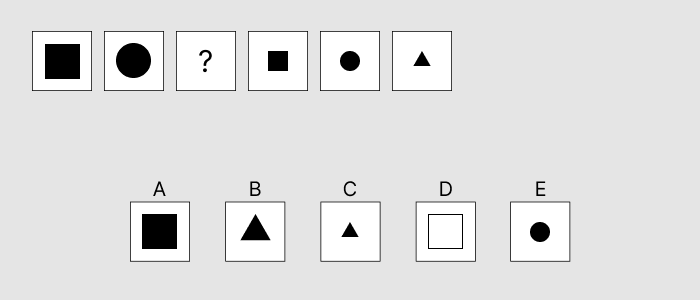
Answer and Explanation
The correct answer is B.
In this simple question, the pattern is that the larger shape (square, circle, triangle) shrinks three steps later. Therefore, the missing shape is a large triangle.
Question #2

Answer and Explanation
The correct answer is D.
The circles in the star move in two different directions:
- The grey circle moves clockwise.
- The black circle moves counterclockwise.
In step 4, the black circle hides the grey circle.
Question #3
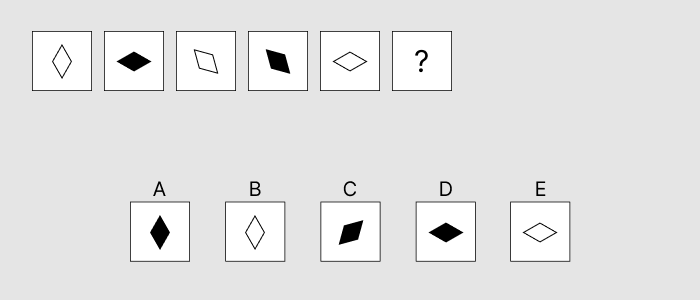
Answer and Explanation
The correct answer is D.
In this question, there are actually two different patterns:
- White diamond – rotates 45 degrees counterclockwise every second step.
- Black diamond – rotates 45 degrees clockwise every second step.
Therefore, the missing shape is a black diamond that is rotated 45 degrees clockwise relative to step 4.
Question #4

Answer and Explanation
The correct answer is E.
This question is more challenging, since it combines several unrelated patterns:
- The shape pattern is (left to right) – circle, star, rectangle, square.
- The size of each shape remains constant throughout the steps.
- The color of the shape, however, follows a pattern of 3 – black, white, white. This type of pattern is rather unique to Saville questions and is named “Frequency”.
Combining these three patterns, the missing shape should be a small, white square.
Pro Tip
A helpful technique in Saville abstract questions is to split the series in various ways (every 2/3/4 steps) and look for patterns in different areas or features of the shape.
Question #5

Answer and Explanation
The correct answer is A.
Again, we have several patterns working together:
- The middle shape interchanges between circle and square.
- The squares are always white, while the circles interchange between white and black.
- The line follows a pattern of 3 – top, top, left ; down, down, right.
Therefore, the missing shape should contain a white circle and a line on the left-hand side.
Question #6
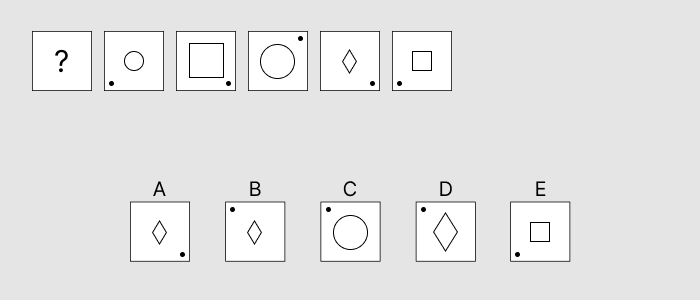
Answer and Explanation
The correct answer is B.
There are three separate patterns here:
- The middle shapes follow a pattern of diamond, circle, square in a changing order.
- This pattern repeats itself with two small shapes and one large.
- The dot moves counterclockwise until it makes a whole round around the square, then turns back and starts moving clockwise.
Therefore, the missing shape should have a small diamond and a dot in the upper left corner.
Pro Tip
Some patterns in abstract Saville questions may “change direction”.
Question #7
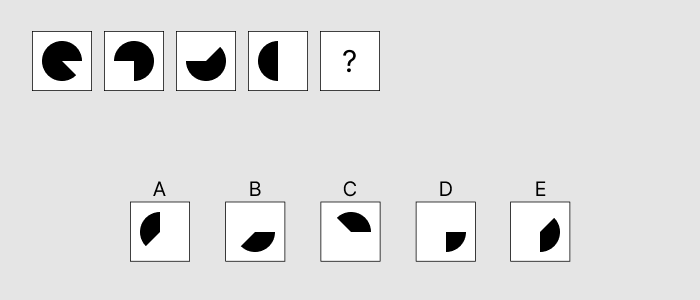
Answer and Explanation
The correct answer is C.
With every step, the black circle sector goes through two consecutive changes:
- A 45-degree sector (slice) is taken off.
- The resulting sector rotates 90 degrees counterclockwise.
Question #8

Answer and Explanation
The correct answer is A.
This question combines two patterns:
- The main shape follows the sequence of square, circle, star.
- Every step, one square is added to the top left corner, unless the main shape is a star.
Therefore, the missing shape should have a star as a main shape, and three squares in the top left corner.
Pro Tip
A further complexity used in Saville abstract questions is conditional changes. For instance, “rotate the external shape 90 degrees, unless the inner shape is a triangle.”

Numerical Analysis
Question #1

What was the average price for which a product was sold this year?
- $102.5
- $110
- $103.1
- $100.5
Answer and Explanation
The correct answer is C.
To find the average selling price, we should divide the total sales revenue made by the total number of products sold, so:
[22 x 135 + 14 x 80 + 36 x 95 + 28 x 100] / [22 + 14 + 36 + 28] = 10,310 / 100 = 103.1.
Since the number of units sold is given in 1000s for all products, we can disregard the 1000s and calculate with the original numbers given in the table.
Note that simply finding the average of all 4 product prices, i.e., (135 + 80 + 95 + 100) / 4 = $102.5 is WRONG. That is because not all products have the same “weight” in the total revenue.
Question #2

Product A was more profitable than Product D.
- True
- False
- Cannot Say
Answer and Explanation
The correct answer is False.
The following table shows the total revenue and profit for all 4 products:

So, while Product A has generated more revenue than Product D, it is less profitable, due to its greater expenses.
Question #3

What was the total number of products sold in Y1?
- 1,357
- 1,125
- 1,241
- 2,482
Answer and Explanation
The correct answer is B.
158 + 622 + 235 + 110 = 1,125
Question #4

Which product has shown the greatest increase in revenue between Y1 and Y2?
- Product A
- Product B
- Product C
- Product D
Answer and Explanation
The correct answer is B.
You may want to solve it differently, but for convenience we’ll show the solution in a table.
|
Product A |
Product B |
Product C |
Product D |
| Y2 |
166 |
755 |
224 |
212 |
| Y1 |
158 |
622 |
235 |
110 |
| Y2-Y1 |
8 |
133 |
-11 |
102 |
| Price |
$15 |
$7 |
$20 |
$8 |
| Revenue |
$120 |
$931 |
-$220 |
$816 |
For example, the increase in revenue for Product A between Y1 and Y2 was:
(166 – 158) x $15 = 8 x $15 = $120.
The total increase in revenue is the sum of all revenue increase (all 4 products):
120 + 931 – 220 + 816 = 1,647.
Question #5

The company’s analysts predict high demand for Product D in Y3, while all other products are expected to yield the same revenue as in Y2. They suggest a price increase on Product D in Y3.
Assuming that the number of Product D units sold remains constant, what is the lowest price required for Product D to become the company’s most revenue-generating product in Y3?
- $17
- $27
- $32.5
- $25
Answer and Explanation
The correct answer is D.
The following table presents the expected revenue for all products in Y2:
|
A |
B |
C |
D |
| Units Sold |
166 |
755 |
224 |
212 |
| Avg. Price |
$15 |
$7 |
$20 |
$8 |
| Revenue |
$2,490 |
$5,285 |
$4,480 |
$1,696 |
Product B is the company’s most revenue-generating product in Y2, with a $5,285 revenue. Therefore, for product D to become the most revenue-generating product in Y3, it should yield at least that amount.
Assuming that Product D sells the same number of units in Y3 as in Y2, the new price for it to be the company’s most revenue is:
212 x New Price = $5,285
New Price = $24.92
Therefore, of the given options, $25 is the lowest price that will put product D as the most revenue-generating product in Y3.
Question #6
Refer to the graph below for questions 6-8.

What percentage of Japan’s coal is imported from Australia?
- 7%
- 20%
- 12%
- 3%
Answer and Explanation
The correct answer is A.
The total coal imported by Japan is (20 + 21 + 33 + 46) = 120 million tons.
The percentage of coal imported from Australia is, therefore, (20/120) = 16.7%
Question #7
Which of the following countries exports the lowest percentage of its coal to the three top importing countries in 2022?
- China
- India
- US
- Australia
Answer and Explanation
The correct answer is B.
The following table shows the total coal production of the 4 top coal producing countries and the total coal imports by the top 3 coal importing countries.
| Country |
Total Production |
Total Exports to UK, Germany, and Japan |
Exports (% of Production) |
| China |
778 |
24 + 12 + 46 = 82 |
82 / 778 = 10.5% |
| India |
620 |
61 |
9.8% |
| US |
410 |
136 |
33.1% |
| Australia |
315 |
50 |
15.9% |
Therefore, India exports the lowest percentage of its coal to UK, Germany, and Japan.
Question #8
By 2023, the following trends are expected to occur in the top coal producing countries, with comparison to 2022:
- China – 5% decrease.
- India – 3% increase.
- US – 8% decrease.
- Australia – No change.
Approximately, what will be the total coal production of the 4 top coal producing countries in 2023 (in million tons)?
- 2,155
- 2,123
- 2,066
- 1,998
Answer and Explanation
The correct answer is C.
Again, let’s summarize the data in a table:
|
2022 |
Change |
2023 |
| China |
778 |
-0.05 |
739.1 |
| India |
620 |
0.03 |
638.6 |
| US |
410 |
-0.09 |
373.1 |
| Australia |
315 |
0 |
315 |
| Total |
2,123 |
|
2,065.8 |
Therefore, the total production of all 4 top coal producing countries in 2023 will be approximately 2,066 million tons.
Verbal Analysis
Text for questions 1-5
Limnic eruption is a very rare type of natural disaster. A very unique combination of circumstances is required to produce such an event, which occurs only in deep volcanic crater lakes near the equator. Therefore, only two cases are documented – the first in Lake Monoun, and the second in Lake Nyos. Both lakes are located in Cameroon, Africa. Nearly 1,800 people have lost their lives in these two events.
While technological solutions have been implemented to prevent further eruptions in these relatively small lakes, local authorities have thus far failed in providing a solution for the enormous Lake Kivu on the Rwanda-DRC border. Experts predict that if a limnic eruption ever takes place in Lake Kivu, it may be the worst natural disaster in modern history.
Question #1
Which word could replace “circumstances” and maintain the original meaning of the sentence?
- resources
- conditions
- eruptions
- failures
Answer and Explanation
The correct answer is B.
The text details a specific combination of conditions/circumstances that need to apply simultaneously for a lake to go through limnic eruption.
Question #2
According to the text, what is the most probable reason that no technology to prevent limnic eruptions was installed in Lake Kivu?
- Its surroundings are too densely populated.
- Authorities in the area are corrupt.
- It lies on a border.
- It is too big.
Answer and Explanation
The correct answer is D.
The text states that “While technological solutions have been implemented…in these relatively small lakes local authorities have thus far failed in providing a solution for the enormous Lake Kivu on the Rwanda-DRC border.”
Therefore, since the text compares the enormous Lake Kivu to the relatively small Lake Nyos and Lake Monoun, it is most probable that this is the reason that no technology was implemented in that lake. While options B (corrupt authorities) and C (lies on a border) are factually true, the text does not suggest them as a reason for the failure in providing a solution for Lake Kivu.
Question #3
Lake Kivu is a deep volcanic crater lake.
- True
- False
- Cannot Say
Answer and Explanation
The correct answer is True.
According to the text, limnic eruptions occur only in deep volcanic crater lakes. As we know that a limnic eruption is possible in Lake Kivu, it necessarily means that it is indeed a deep volcanic crater lake (and is located near the equator).
Question #4
Which title would fit best for the second paragraph?
- Limnic Eruptions – A Rare Event
- The Limnic Eruption in Lake Kivu
- The Catastrophe of Our Time May Be Ahead
- The Three Killer Lakes of Africa
Answer and Explanation
The correct answer is C.
The second paragraph discusses the possibility of a limnic eruption in Lake Kivu, and its possible consequences – “the worst natural disaster in modern history”.
Answers A and D are wrong as these topics are discussed in the first paragraph either fully (A) or partly (D).
Answer B is wrong since such a title indicates that a limnic eruption has already occurred in Lake Kivu.
Question #5
Which paragraph is more critical?
- Paragraph 1
- Paragraph 2
- Both paragraphs
- None
Answer and Explanation
The correct answer is B.
Paragraph 1 is purely informative and provides information about the history and causes of limnic eruptions. Paragraph 2, however, points out that “authorities have failed” to provide a solution for a possible limnic eruption in Lake Kivu.
While the text does not explicitly blame local authorities for anything, it does suggest that it is their responsibility that no action was taken thus far. The text also details the possible and dire consequences of such a failure.
Texts for questions 6-8
GDP per Capita
GDP per capita is defined as a country’s GDP (Gross Domestic Product), divided by the total population of that country. GDP, in turn, is the monetary value of all goods and services produced in this country over one year.
For decades, this metric has been considered to be the best representation of a country’s wealth, and indeed, countries who rank highest in international comparisons are nearly always very economically developed and wealthy countries.
While criticism of GDP per capita as the major indicator of wealth is on the rise in the last decade, and several other indicators have been suggested to replace it, international financial institutions still rely on this classic metric.
Quote by Christian von Lambach
“There comes a time in which one is required to make a major mindset shift, even regarding concepts that are considered classic. As an economist, I would probably put GDP per capita in the list of top-ten ideas that seriously need this shift.
The main reason is that this statistic bluntly ignores the actual people whose condition it supposedly measures. Firstly, by failing to address issues like purchasing power and inflation, and secondly, the very loose relationship between top-ranking countries and the actual welfare of their average citizen.”
Question #6
The word “metric” can be BEST replaced by:
- Information
- Structure
- Way of measurement
- Quality
Answer and Explanation
The correct answer is C.
“Metric” means a method of quantitatively describing or measuring something. GDP per capita is an example of a metric used to quantify a country’s wealth.
Other examples: life expectancy (health), Gini coefficient (inequality of wealth), etc.
Question #7
International financial institutions disagree with Christian von Lambach regarding GDP per capita.
- True
- False
- Cannot Say
Answer and Explanation
The correct answer is Cannot Say.
While we know that international financial institutions are still using GDP per capita as a major metric, in spite of criticism, we have no information to conclude the reason. The fact that these institutions still use GDP per capita does not necessarily suggest that they think it is the best possible metric.
An alternative explanation may be, for instance, that the data gathered thus far is measured in GDP per capita and changing that metric may be a laborious and slow process.
Question #8
Which text is overly critical of the usage of GDP per capita?
- GDP per Capita
- Quote of Christian von Lambach
- Both texts
- None
Answer and Explanation
The correct answer is B.
Von Lambach is very critical of the use of GDP per capita as the major metric to measure a country’s wealth: “GDP per capita [is] in the list of top-ten ideas that seriously need this [mindset] shift.” ; “bluntly ignores the actual people whose condition it supposedly measures.”
The first text mentions that criticism of the GDP per capita metric exists, but does not express an explicit opinion in favor or against it, and maintains a much more neutral and informative style.
Saville Testlets
This section gives a deeper overview of the 4 major Saville test sections (testlets) – Abstract, Diagrammatic, Numerical, and Verbal.
You may find free questions and answers for each testlet in the dedicated Saville Swift Analysis and Saville Swift Executive sections.
Saville assessments are based on combinations of testlets (test sections) in various topics. In total, there are 7 testlets – Numerical, Verbal, Abstract, Diagrammatic, Error Checking, Spatial, and Mechanical.
The first 4 testlets – Numerical, Verbal, Abstract, and Diagrammatic, are by far the most popular ones, as they are used in Saville’s two most widely used tests – the Saville Swift Executive Aptitude and the Saville Swift Analysis Aptitude.
Let’s go over each of them.
Abstract Reasoning
The Saville Abstract Reasoning testlet assesses your ability to identify patterns presented in abstract shapes and correctly apply them to solve problems.
Unlike the numerical and verbal testlets, the abstract section includes only one question type, known as Next in Series.

In Next in Series questions, you are presented with a sequence of shapes that follow a set of rules. Your task is to identify the rules and decide which of the 5 answer options correctly completes the sequence.
Pro Tip
Saville abstract questions have several unique features. We demonstrate all these features with solved sample questions in the Saville Swift Executive section.
- Missing shapes may be located anywhere in the sequence.
- Rules may change in the middle of the sequence.
- Frequency patterns are often used.
- Conditional rules are used to increase challenge.
Diagrammatic Reasoning
The Saville Diagrammatic Reasoning testlet assesses your ability to understand logical rules and processes presented in diagrams.
Similar to the abstract section, the Saville diagrammatic section includes only one question type.

Each question has 3 components:
- Input
- Output
- Operator – the logical process that converts the input to output.
In every question, your task is to find one missing component based on the other two. 4 answer options are given to choose from.
Numerical Analysis
The Saville Numerical Analysis testlet assesses your ability to interpret, analyze, and draw conclusions from numerical data.
The questions in the numerical testlet assess 5 different abilities, through 5 different item types:
- Understanding Tables
- Comprehending Graphs
- Making Numerical Inferences
- Evaluating Quantities
- Comparing Data
Let’s briefly explain each of these abilities, including one sample question.
Understanding Tables
This item type assesses your ability to understand a table containing numerical data.
Sample Question

What was the average price for which a product was sold this year?
- $102.5
- $110
- $103.1
- $100.5
Making Numerical Inferences
This item type assesses your ability to draw correct conclusions based on numerical data. These items are formatted as True/False/Cannot Say questions.

Product A was more profitable than Product D.
- True
- False
- Cannot Say
Comprehending Graphs
This item type assesses your ability to understand trends and data in a graph.
Sample Question

What was the total number of products sold in Y1?
- 1,357
- 1,125
- 1,241
- 2,482
Evaluating Quantities
This item type assesses your ability to make quantitative evaluations based on given conditions and numerical data.
Sample Question

The company’s analysts predict high demand for Product D in Y3, while all other products are expected to yield the same revenue as in Y2. They suggest a price increase on Product D in Y3.
Assuming that the number of Product D units sold remains constant, what is the lowest price required for Product D to become the company’s most revenue-generating product in Y3?
- $17
- $27
- $32.5
- $25
Comparing Data
This item type assesses the ability to compare data within or between data sets.
Sample Question

Which product has shown the greatest increase in revenue between Y1 and Y2?
- Product A
- Product B
- Product C
- Product D
Verbal Analysis
The Saville Verbal Analysis testlet assesses your ability to interpret, analyze, and draw conclusions from texts.
The questions in the verbal testlet assess 5 different abilities, through 5 different item types:
- Understanding Word Meaning
- Comprehending Text
- Making Verbal Inferences
- Evaluating Written Materials
- Comparing Arguments
Let’s briefly explain each of these abilities, including one sample question.
Limnic eruption is a very rare type of natural disaster. A very unique combination of circumstances is required to produce such an event, which occurs only in deep volcanic crater lakes near the equator. Therefore, only two cases are documented – the first in Lake Monoun, and the second in Lake Nyos. Both lakes are located in Cameroon, Africa. Nearly 1,800 people have lost their lives in these two events.
While technological means have been implemented to prevent further eruptions in these relatively small lakes, local authorities have thus far failed in providing a solution for the enormous Lake Kivu on the Rwanda-DRC border. Experts predict that if a limnic eruption ever takes place in Lake Kivu, it may be the worst natural disaster in modern history.
Understanding Word Meaning
This item type assesses your ability to understand the meanings of words within the text.
Which word could replace “circumstances” and maintain the original meaning of the sentence?
- resources
- conditions
- eruptions
- failures
Comprehending Text
This item type assesses your ability to understand the content of the text in general.
According to the text, what is the most probable reason that no technology to prevent limnic eruptions was installed in Lake Kivu?
- Its surroundings are too densely populated.
- Authorities in the area are corrupt.
- It lies on a border.
- It is too big.
Making Verbal Inferences
This item type assesses your ability to draw correct conclusions based on the text. These items are formatted as True/False/Cannot Say questions.
Lake Kivu is a deep volcanic crater lake.
- True
- False
- Cannot Say
Evaluating Written Materials
This item type assesses your ability to conclude the main points of the text.
Which title would fit best for the second paragraph?
- Limnic Eruptions – A Rare Event
- The Limnic Eruption in Lake Kivu
- We May Be Ahead of the Worst Natural Disaster of Our Time
- The Three Killer Lakes of Africa
Comparing Arguments
This item type assesses the ability to compare arguments within or between texts.
Which paragraph is more critical?
- Paragraph 1
- Paragraph 2
- Both paragraphs
- None
Other Saville Testlets
In addition to the 4 major testlets described above, Saville tests use 3 additional testlets for smaller, less popular assessments:
- Error Checking
- Spatial Reasoning
- Mechanical Reasoning
Preparation
For the best prep experience, we strongly recommend JobTestPrep’s Saville Swift Aptitude Tests Preparation. Below we will give you all the reasons why this is the prep course you should choose. All screenshots are taken from the prep course.
Full Disclosure: We are affiliated with JobTestPrep. Clicking the links helps us provide you with high-quality, ad-free content.
Questions Are Tailored for the Actual Assessment
All questions on the Saville Swift Executive and Saville Swift Analysis prep courses are tailored for the actual Saville Swift tests:
- The unique diagrammatic reasoning questions are covered.
- Questions follow the format and difficulty level of the actual test.


Everything You Need
Whether you are taking the Saville Swift Analysis, Executive, or Comprehension Aptitude test, JobTestPrep’s Saville Test Prep Course has you covered, for the same price.
If you still want a tailored prep just for your test, you can go for the Saville Analysis Aptitude Prep or the Saville Executive Aptitude Prep.
JobTestPrep occasionally change the prices of various Saville products, so check the best option for your needs.
Authentic Mock Tests
Each of the 3 mock tests in the preparation course follows the real assessment’s number of questions and time limit.
This way, you get an authentic testing experience that improves your solving speed and time management skills.

Additional Focused Practice
The Saville preparation course includes dozens of additional practice tests that focus on particular sections of the assessment. That way, you can further strengthen your weaker areas and maximize your score.
Saville Wave Test Preparation
The Saville Swift Aptitude Test will often be followed by the Wave Personality test, so it is highly recommended to be familiar with it as well, as part of your preparation process.
JobTestPrep is currently the only resource offering a valuable, accurate prep course for the Saville Wave Personality test – an authentic, personalized Saville Wave test experience, employing the actual test’s formatting and scoring method of the actual assessment.
Personalized for Your Job

Follows the Real Test Structure

Get serious about your career! Start preparing for your Saville Assessment!
Start Preparing Now































